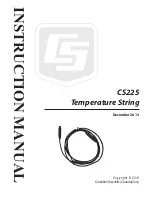
BLOCK DIAGRAM DESCRIPTION
particular area (this is block (10)). As with displacement VCEQ, another set of mechanical
stress VCEQ is needed for band-pass cabinets (this is block (11)).
HF displacement control (12)
In case of passive setups, a channel will deal with several loudspeakers after passing
through the passive filter of the cabinet. That is why, as previous VCEQs deal with LF
loudspeaker, another set of VCEQ is needed to protect HF driver from excessive
displacement.
HF acceleration control (13)
Excessive acceleration on the HF driver can lead to the destruction of the diaphragms.
Another set of VCEQ is added here to protect HF driver from over acceleration.
Global purpose VCEQ (14)
The internal structure of the VCEQs processes inside the DSP allow up to eight different
VCEQ, in case you need extra VCEQing for dynamic EQ or whatever…
Loudspeaker Peak limiters (15)
These “loudspeaker” peak limiters are here to avoid huge amounts of power being sent to
a driver. Each driver is protected in temperature and displacement but there could be other
factors of destruction that cannot be predicted by simulation (especially mechanical
damage to the cone…). Each driver is specified for a certain power handling and a factory
set peak limiter threshold is tuned to avoid any abuse. A two-steps peak limiter is used
here, each with a separate set of threshold, ratio, attack and release.
Temperature control (16) (17)
The sense signal from amplifier output is fed into a shaping filter, each one producing a
signal proportional to the instantaneous current flowing into the voice coil of the
transducer. After rectification, this signal is integrated with attack and release time
constants equivalent to the thermal time constants of the voice coil and chassis, producing
a voltage, which is representative of the instantaneous temperature of the voice coil.
When this voltage reaches the threshold value corresponding to the maximum safe
operation temperature, the VCA or the VCEQ becomes active to reduce the Audio signal
level and limit the effective temperature to fall under the maximum usable value.
In order to avoid detrimental effects induced by very long release time constants coming
from the temperature detection signal (level being reduced for an extended period,
« pumping » effects...), the detection signal is modulated by another voltage integrated
with faster time constants matching the sound level subjective perception. This allows the
controller to reduce the effective operation duration of the temperature limiter and make it
sound more natural, while the efficiency of protection is fully preserved and operation
thresholds are unaffected (kept as high as possible).
In case of passive cabinet, another set of temperature simulation is done to protect the
H.F. driver; this is block (17).
PAGE 36 OF 91
















































